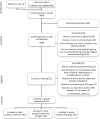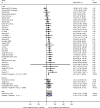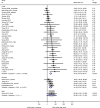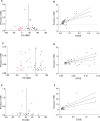Preclinical Evidence for the Efficacy of Ischemic Postconditioning against Renal Ischemia-Reperfusion Injury, a Systematic Review and Meta-Analysis
- PMID: 26963819
- PMCID: PMC4786316
- DOI: 10.1371/journal.pone.0150863
Preclinical Evidence for the Efficacy of Ischemic Postconditioning against Renal Ischemia-Reperfusion Injury, a Systematic Review and Meta-Analysis
Abstract
Background: Renal ischemia-reperfusion injury (IRI) is a major cause of kidney damage after e.g. renal surgery and transplantation. Ischemic postconditioning (IPoC) is a promising treatment strategy for renal IRI, but early clinical trials have not yet replicated the promising results found in animal studies.
Method: We present a systematic review, quality assessment and meta-analysis of the preclinical evidence for renal IPoC, and identify factors which modify its efficacy.
Results: We identified 39 publications studying >250 control animals undergoing renal IRI only and >290 animals undergoing renal IRI and IPoC. Healthy, male rats undergoing warm ischemia were used in the vast majority of studies. Four studies applied remote IPoC, all others used local IPoC. Meta-analysis showed that both local and remote IPoC ameliorated renal damage after IRI for the outcome measures serum creatinine, blood urea nitrogen and renal histology. Subgroup analysis indicated that IPoC efficacy increased with the duration of index ischemia. Measures to reduce bias were insufficiently reported.
Conclusion: High efficacy of IPoC is observed in animal models, but factors pertaining to the internal and external validity of these studies may hamper the translation of IPoC to the clinical setting. The external validity of future animal studies should be increased by including females, comorbid animals, and transplantation models, in order to better inform clinical trial design. The severity of renal damage should be taken into account in the design and analysis of future clinical trials.
Conflict of interest statement
Figures






References
-
- Perico N, Cattaneo D, Sayegh MH, Remuzzi G (2004) Delayed graft function in kidney transplantation. Lancet 364: 1814–1827. - PubMed
-
- Roodnat JI, Mulder PG, Van Riemsdijk IC, JN IJ, van Gelder T, Weimar W (2003) Ischemia times and donor serum creatinine in relation to renal graft failure. Transplantation 75: 799–804. - PubMed
-
- Zhao ZQ, Corvera JS, Halkos ME, Kerendi F, Wang NP, Guyton RA, et al. (2003) Inhibition of myocardial injury by ischemic postconditioning during reperfusion: comparison with ischemic preconditioning. Am J Physiol Heart Circ Physiol 285: H579–588. - PubMed
-
- Kerendi F, Kin H, Halkos ME, Jiang R, Zatta AJ, Zhao ZQ, et al. (2005) Remote postconditioning. Brief renal ischemia and reperfusion applied before coronary artery reperfusion reduces myocardial infarct size via endogenous activation of adenosine receptors. Basic Res Cardiol 100: 404–412. - PubMed
Publication types
MeSH terms
LinkOut - more resources
Full Text Sources
Other Literature Sources
Medical

